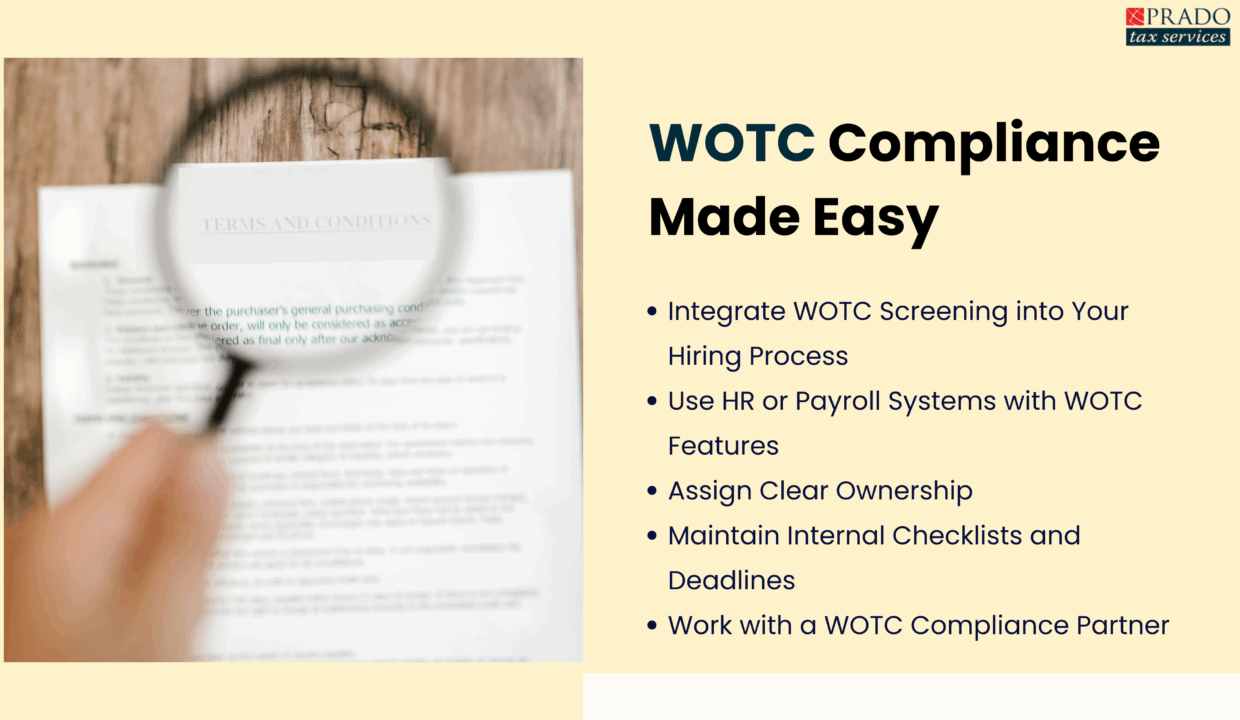The Work Opportunity Tax Credit (WOTC) is a valuable federal incentive program that rewards employers for hiring individuals from certain targeted groups who face significant barriers to employment. But to unlock these tax benefits, potentially worth thousands of dollars per hire, timing is everything.
At the heart of the WOTC process is IRS Form 8850, the Pre‑Screening Notice and Certification Request. While filling it out correctly is important, submitting it on time is absolutely critical. A single missed deadline can mean the difference between claiming a credit and forfeiting it altogether.
In this article, we break down everything employers need to know about Form 8850 deadlines, including the strict 28-day filing rule, common mistakes, and practical strategies to stay compliant. Whether you’re managing a high-volume hiring process or onboarding your first qualifying employee, this guide will help you avoid costly delays and preserve your eligibility for the WOTC program.
What Is Form 8850?
Form 8850, officially titled the Pre-Screening Notice and Certification Request for the Work Opportunity Credit, is a required document for employers seeking to claim the Work Opportunity Tax Credit (WOTC). It serves as a formal notice that an employer intends to hire someone who may belong to one of the target groups eligible for the credit.
The form plays a critical role in the WOTC application process. It allows employers to screen applicants for eligibility before or at the time of making a job offer. By collecting this information up front, employers can ensure their new hire qualifies before proceeding with further certification steps.
Form 8850 has two parts:
- Section 1 is completed by the job applicant. It includes personal details and a series of questions to determine eligibility.
- Section 2 is filled out by the employer, confirming the job offer and other key information.
This form must be initiated no later than the date of the job offer and submitted to the appropriate State Workforce Agency (SWA) within 28 calendar days after the employee begins work. Missing this deadline disqualifies the employer from claiming the WOTC for that hire, regardless of the employee’s eligibility.
The 28-Day Deadline Rule Explained
One of the most important rules employers must follow when claiming the Work Opportunity Tax Credit is the 28-day submission deadline for Form 8850. This rule is strict and non-negotiable.
According to the IRS Instructions for Form 8850:
“Form 8850 must be signed on or before the day a job offer is made and must be submitted to the SWA no later than the 28th calendar day after the individual begins work.”
– Source: IRS.gov Form 8850 Instructions (PDF)
Therefore, to remain eligible for the credit, an employer must submit Form 8850 to the appropriate State Workforce Agency no later than 28 calendar days after the employee’s start date. This means the clock starts ticking the day the new hire begins work, not when the offer is made or accepted.
The deadline applies to all WOTC target groups, without exception. Submitting the form even one day late can result in a total loss of eligibility for that hire, regardless of whether the employee clearly qualifies for the credit.
It’s also important to understand what counts as the start date. The IRS defines it as the first day the employee actually performs services for pay , not the offer date or the onboarding date.
In short:
- Form 8850 must be completed and submitted within 28 days of the employee’s first day on the job
- The form must be sent to your state’s workforce agency, not the IRS
- There are no extensions or grace periods
This rule forms the foundation of WOTC compliance and is where many employers unintentionally disqualify themselves.
Why Deadlines Are So Critical
Missing the 28-day deadline for submitting Form 8850 means your business is no longer eligible to claim the Work Opportunity Tax Credit for that hire, even if the employee meets every other requirement. There are no exceptions, extensions, or appeals once the deadline has passed.
The Department of Labor instructs SWAs to reject any untimely applications:
“Employers must submit IRS Form 8850 to the SWA within 28 calendar days of the eligible new hire’s start date. Late forms are not accepted.”
– Source: DOL.gov TEGL 4-12 Attachment 6 (PDF)
The IRS and Department of Labor treat the timing of Form 8850 as a strict compliance requirement. State Workforce Agencies are instructed to automatically reject any forms that arrive after the 28-day window. That means even a one-day delay due to mailing issues, internal miscommunication, or HR oversight can lead to a denied claim.
This makes Form 8850 one of the most time-sensitive parts of the WOTC process. Failing to file on time could cost your company between $2,400 and $9,600 per eligible hire, depending on the target group.
In competitive industries where turnover is high and hiring volumes are large, these losses add up quickly. That’s why employers who rely on the WOTC program often build deadline alerts, workflows, or automation tools into their onboarding process to make sure Form 8850 is submitted accurately and on time.
Step-by-Step Timeline Example
Understanding how the 28-day deadline works in real-life hiring scenarios can help avoid costly mistakes. Below is a simple example of how the Form 8850 filing timeline should play out:
Example Timeline:
- July 1 – Employee’s first day of work (start date)
- By July 28 – Form 8850 must be received by the State Workforce Agency
It’s important to note that this deadline is not based on postmark or the date the form was signed. The form must arrive at the state agency within 28 calendar days of the start date , not business days, and not including any grace period.
Best Practice:
To stay on the safe side, employers should aim to submit Form 8850 within 7 to 10 days after the employee starts work. This allows extra time for:
- Weekends or state holidays
- Delays due to mail or fax issues
- Internal processing or reviews
Some states also offer online submission portals that confirm delivery instantly, which can help meet the deadline more reliably.
By treating the 28-day rule as a hard cutoff and building in a margin of safety, employers can protect their WOTC eligibility and avoid last-minute issues.
How to File Form 8850 on Time
Submitting Form 8850 on time is just as important as filling it out correctly. Once the employee starts work, the employer has exactly 28 calendar days to make sure the form reaches the correct State Workforce Agency (SWA).
Submission methods vary by state. Many state workforce agencies allow mailing, faxing, or electronic upload of Form 8850 and required ETA forms.

Choose the Correct Submission Method
Each state has its own process for receiving Form 8850. Common methods include:
- Mail – Use certified or priority mail with tracking to prove timely delivery.
- Fax – Some states still accept fax submissions; confirm the number and keep a confirmation page.
- Online Portals – Many states offer secure online systems that allow instant digital submission and confirmation. Examples include:
- California’s WOTC online system (EDD)
- Washington’s eServices portal
- Texas Workforce Commission’s WOTC portal
- California’s WOTC online system (EDD)
Follow State-Specific Requirements
Each state may have slightly different requirements for:
- Which forms to submit (some require ETA Form 9061 along with Form 8850)
- How to package documents
- Whether an employer registration is needed for online access
To avoid delays, check your state’s official WOTC page before sending the form.
Keep Proof of Submission
Always retain a record showing when and how you submitted the form. This could be:
- A postal receipt or tracking number
- A fax confirmation page
- An email or system timestamp from a digital portal
This documentation can protect you if there’s ever a question about whether the form was submitted on time.
Common Deadline Mistakes to Avoid
Even well-meaning employers can lose their WOTC eligibility due to simple, preventable errors. Below are some of the most common mistakes businesses make when it comes to Form 8850 deadlines:
1. Confusing the Start Date with the Offer Date
The 28-day clock starts on the employee’s first day of work, not the day the offer is made or accepted. Submitting based on the wrong date can result in late filing.
2. Waiting Until the Last Minute
Trying to send the form on day 27 or 28 leaves no room for errors, delivery issues, or missing documentation. If there’s any delay, the form may arrive late and be automatically rejected.
3. Not Using Trackable Delivery Methods
Submitting by regular mail without tracking makes it impossible to prove timely submission. Always use certified mail, fax confirmation, or portal receipts.
4. Relying Solely on Third-Party Vendors
Outsourcing WOTC processing is helpful, but employers are still responsible for compliance. Without internal oversight, deadlines can slip through the cracks.
5. Lack of a Standardized Workflow
If your HR team doesn’t have a documented onboarding checklist that includes Form 8850, it’s easy to overlook the form or miss the deadline, especially in high-volume hiring periods.
Avoiding these mistakes starts with awareness, clear processes, and assigning ownership of WOTC compliance to someone on your team.
What If You Miss the Deadline
If you miss the 28-day deadline to submit Form 8850, you cannot claim the Work Opportunity Tax Credit for that employee, even if they fully qualify. The IRS and U.S. Department of Labor make this policy clear: late submissions are not accepted, and there is no appeal process.
State Workforce Agencies are instructed to automatically reject any Form 8850 that arrives after the 28-day window, regardless of the reason for the delay. This means common issues like internal miscommunication, postal delays, or simple oversight will still result in disqualification.
“Employers must submit IRS Form 8850 to the SWA within 28 calendar days of the eligible new hire’s start date. Late forms are not accepted.”
– U.S. Department of Labor, TEGL 4-12 Attachment 6 (PDF)
If you’ve missed the deadline:
- Document the incident internally so it doesn’t repeat
- Audit your onboarding process to ensure deadlines are integrated
- Consider using WOTC technology partners to automate compliance
- Assign ownership of Form 8850 tracking to a dedicated HR or payroll team member
Although you can’t retroactively claim the credit for that hire, you can prevent future losses by tightening your process going forward.
See how companies across industries use Walton to improve WOTC compliance.
Automating Compliance: WOTC Filing Best Practices
Given the strict deadline and no-exceptions policy for Form 8850, many employers are turning to automation to reduce risk and simplify the filing process. Building WOTC compliance into your onboarding workflow not only protects your eligibility but also improves efficiency across hiring teams.

1. Integrate WOTC Screening into Your Hiring Process
Start by including Form 8850 screening during the job application or onboarding phase. This ensures eligible candidates are identified early and that required forms are signed before the deadline even begins.
2. Use HR or Payroll Systems with WOTC Features
Many applicant tracking systems (ATS) and HR platforms now offer WOTC modules that:
- Auto-fill and store Form 8850
- Track days remaining until the 28-day cutoff
- Submit forms electronically to state agencies (if supported)
- Alert HR teams when action is needed
This reduces manual effort and minimizes the chance of missing deadlines.
3. Assign Clear Ownership
Designate a specific person or team, often within HR or payroll, as responsible for tracking WOTC activity. This includes verifying eligibility, preparing and submitting forms, and ensuring state confirmation is received and recorded.
4. Maintain Internal Checklists and Deadlines
Use internal checklists or digital workflows to make Form 8850 part of your standard onboarding process. Include deadlines and reminders to ensure action is taken within the first few days of the new hire’s start date, not on day 28.
For official WOTC process steps and filing instructions, refer to the U.S. Department of Labor:
How to File for WOTC – dol.gov
5. Work with a WOTC Compliance Partner
Third-party providers like Walton Management Services specialize in WOTC compliance. They offer tools, process audits, and full-service filing support, helping employers capture every eligible credit without the risk of deadline errors.
With automation, accountability, and expert support in place, employers can protect every eligible hire and confidently maximize their tax credit potential.
Conclusion
Form 8850 is the gateway to claiming the Work Opportunity Tax Credit, but only if it’s submitted on time. The 28-day deadline from the employee’s start date is firm and enforced by both the IRS and the U.S. Department of Labor. Missing it means forfeiting valuable tax credits that could amount to thousands of dollars per qualifying hire.
By understanding the timing rules, building compliance into your hiring workflow, and using automated tools or expert partners, your business can stay ahead of the deadline and fully leverage the benefits of the WOTC program.
Don’t let paperwork or process gaps stand in the way of your tax savings. If you’re looking to streamline your WOTC process or avoid costly mistakes, Walton Management Services can help you manage Form 8850 compliance from start to finish.
For official guidance on WOTC and Form 8850 requirements, visit:
IRS Instructions for Form 8850 (PDF)
DOL WOTC Filing Overview

